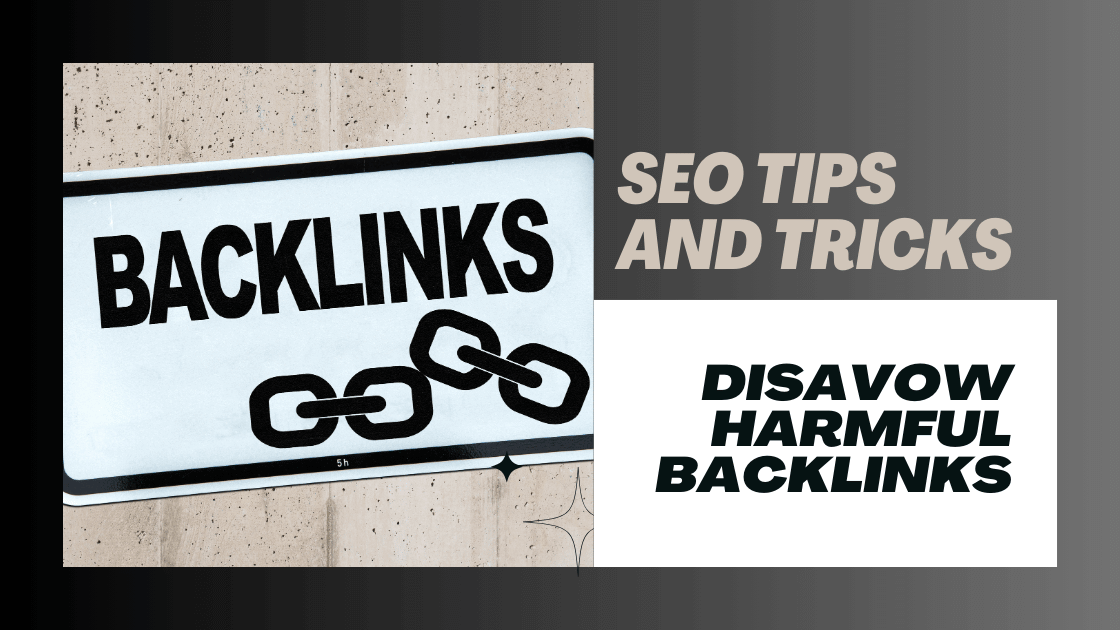Learn to identify and remove harmful backlinks affecting your site’s SEO, with step-by-step instructions for using Google’s disavowal tool.
The following is a guest post from my bloggy friend Taylor McKnight on behalf of Franchise Direct AU. Interested in having a guest post on my website? Click here for my guest post submission form.
Key takeaways from this post:
– Understanding what makes a backlink harmful
– How to properly identify toxic backlinks
– Step-by-step process for disavowing links
– Google’s guidelines for link disavowal
– How to monitor results after disavowal
– Warning signs of harmful backlinks
– Best practices for backlink management
– Common mistakes to avoid in link building
Protecting Your SEO: A Step-by-Step Guide to Backlink Disavowal
Perhaps you’ve heard the word “backlink” used before, but what exactly are they and why are they significant? In this article, we will break it down for you and teach you how to disavow bad backlinks that could hurt your ‘s ranking. Let us get started!
What to Know When Adding Backlinks on Your Site
When adding backlinks to your website, it is important to keep a few things in mind.
First, ensure that the backlinks you are including are from reputable websites. Steer clear of anyone offering to sell you links or asking for money in exchange for including a link on your website. Not only could this provoke a Google penalty, but it could also damage your website’s reputation.
Second, ensure that the backlinks you include are relevant to your website. Do not just include links for the sake of including links; make sure they add value to your site and help your visitors find what they are looking for.
Third, make sure that the backlinks you are including are high-quality. This means they are not spammy or low-quality and add value to your website.
By keeping these things in mind, you can be sure that your website benefits from quality backlinks.
Why Disavowing Backlinks Is Important
You have probably heard the term “backlinks” before, and you may even know they are important for your website’s SEO. But what exactly are backlinks, and why is it so important to disavow them?
Backlinks are just links pointing to your website from other websites. They are one of the key elements that Google considers when determining the position of your website in search results. The more high-quality backlinks you have, the higher you will rank.
But not all backlinks are good. Some can hurt your ranking and damage your website. That is why it is so important to disavow them—to remove them from your site’s link profile and keep them from doing any damage.
Understanding Google’s Guidelines for Link Disavowal
So you have decided that you need to disavow some links. That is a big decision, and it should not be taken lightly. Before you start the process, it is important to understand Google’s guidelines for link disavowal.
First and foremost, you need to be absolutely sure that the links in question are causing you harm. You cannot just disavow links because you do not like them or because they are from a competitor. If you are not sure whether or not a link is causing you harm, ask yourself these questions:
-Are my rankings dropping?
-Am I seeing a decrease in organic traffic?
-Are my pages getting de-indexed?
-Are my competitors outranking me with less links?
If your answer to any of these questions is yes, then it is likely that the links in question are harming your site.
Once you have confirmed that the links are harmful, the next step is to gather as much information as possible about them. This includes the source of the link, the date it was added, and any other relevant information. You will need this information later on when you create your disavow file.
Submitting Your Disavowal Request to Google
Once you have collected all the bad links you want to disavow, it is time to submit your request to Google. You will create a text file and upload it to the Google Search Console.
First, go to the Search Console and select your website. Then, click on the “Search Traffic” drop-down menu and select “Links.”
Next, click on the “More” drop-down menu and select “Disavow Links.”
Now, you will see a screen that says “Type (or copy-paste) URLs,” with a button that says “Choose File.” This is where you will upload your text file.
Once you have selected your file, click on the “Submit” button.
Moreover, that is it! You have now submitted your disavowal request to Google.
Monitoring Results After the Disavowal Process
So, you have gone through the process of creating your list of backlinks and uploading it to Google. Now what?
The next step is to monitor your results to see if the disavowal process is working. This can be done in a few different ways.
One way is to use Google Analytics to see if there has been any change in your organic traffic. If there is a significant drop in traffic after you upload your list, the disavowal process is likely working, and Google is starting to ignore the bad links.
Another way to monitor your results is to use a tool like Monitor Backlinks. This tool will allow you to see which of your backlinks are still active and which have been removed.
You might need to provide an updated list or get in touch with the site owners personally to request that they take down the links if you see that there are still a lot of poor links leading to your website.
How to Identify Unwanted Backlinks
There are a few telltale signs that can help you identify unwanted backlinks. Here are some of the most common ones:
• The backlink is from a low-quality website.
• The backlink is from a website unrelated to your industry or niche.
• The backlink is from a website that’s been penalized by Google.
• The backlink is from a website with low Google authority.
• The backlink is from a website with low AlexaRank.
If you see any of these signs, disavow the backlink.
Techniques for Disavowing Unwanted Backlinks
Let us say you have done your due diligence and have been monitoring your website’s backlinks. You have been using the techniques we have outlined so far, and you have been disavowing any unwanted backlinks as they have come up. However, one day, you notice an influx of spammy backlinks hurting your site’s ranking. What do you do?
Well, the good news is that you can still disavow those links. You can disavow them using the Google Search Console even if they have already been added to your website. Just follow these steps:
1. Log in to the Google Search Console.
2. In the left-hand menu, select “Links to Your Site.”
3. Under “Who Links the Most,” select “More.”
4. Under “Anchor Text,” select “Discovery.”
5. Click the link for the spammy backlink you want to disavow.
6. In the “Status” column, select “Disavowed.”
7. Click “Save.”
Tips for Identifying Beneficial Backlinks
To help you identify whether a backlink is good or bad, here are some tips:
– Check the domain authority of the site. A high DA means the site is a credible source, and its link will likely benefit your site.
– Look at the relevancy of the site. Its link will be more valuable if the site is relevant to your industry or niche.
– See how many other outbound links are on the page. If there are many other links, the link juice will be diluted, and the link may need to be more valuable.
– Check if the link is a follow or nofollow link. A follow link will pass along some link juice and help your site, while a nofollow link will not.
Warning Signs of Unhelpful or Dangerous Backlinks
A few things to look out for might indicate that a backlink is doing more harm than good. If you see any of the following warning signs, it is time to disavow that link!
– The site linking to you has much spammy-looking content. This could include too many ads, unrelated content, or grammatical errors.
– The site linking to you has a bad reputation. This could mean that it has been penalized by Google or is known for link farms or other shady practices.
– The site linking to you has very little content. This could be a sign that it is a new site or not a well-maintained site.
– You see a sudden drop in traffic after the backlink was added. This could indicate that the backlink is lowering your site’s credibility in Google’s eyes.
Common Mistakes to Avoid When Choosing Backlinks
People make a few common mistakes when choosing backlinks for their websites. Here are a few to avoid:
– Only choose backlinks based on PageRank. Just because a site has a high PageRank does not mean that it is a good link for your site.
– Do not buy links. Google will penalize you if they catch you doing this.
– Do not get links from link farms or link directories. These are low-quality links that can hurt your site.
– Do your research before choosing a backlink. Make sure that the site is relevant to your site and that it has a good reputation.
Backlinks are an important part of SEO, but ensuring you only use high-quality links to improve your site is crucial. Use our guide to disavow any unwanted or harmful links and to identify and use high-quality backlinks that will help your site rank higher.











